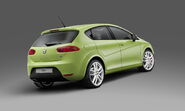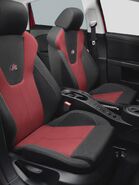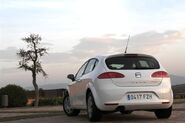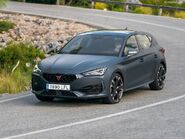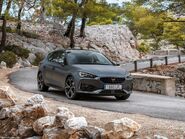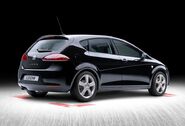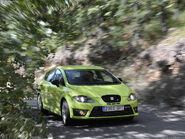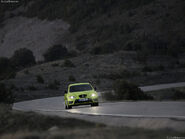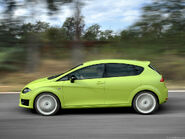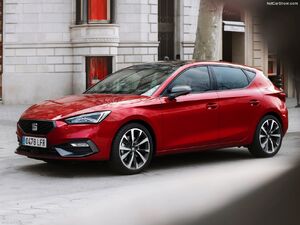
| |
| SEAT León | |
|---|---|
| SEAT | |
| aka | None |
| Production | 1999-Present |
| Class | Small family car |
| Body Style | 3-door hatchback (2013–)
5-door hatchback 5-door estate (2013–) |
| Length | 4,228 mm (166.5 in) 3 Door
4,263 mm (167.8 in) 5 Door |
| Width | 1,810 mm (71.3 in) |
| Height | 1,446 mm (56.9 in) |
| Wheelbase | 2,636 mm (103.8 in) |
| Weight | 1,193–1,261 kg (2,630–2,780 lb) |
| Transmission | 5-speed manual
6-speed manual 6-speed automatic 7-speed automatic |
| Engine | 1.2 L I4 TSI petrol
1.4 L I4 TSI petrol 1.8 L I4 TSI petrol 2.0 L I4 TSI petrol 1.6 L I4 TDI diesel 2.0 L I4 TDI diesel |
| Power | N/A hp @ N/A rpm N/A lb-ft of torque @ N/A rpm |
| Similar | Audi A3 Mk3
Volkswagen Golf Mk7 Škoda Octavia Mk3 |
| Designer | Designer (lead designer if it was a team effort) |
The SEAT León is a small family car built by SEAT, S.A. under Volkswagen Group since October 1998. The León is components with the Volkswagen Golf, Volkswagen Jetta, Audi TT, Audi A3 and Škoda Octavia.
See Autopedia's comprehensive SEAT León Review.
Recent Changes[]
- The 2009 Frankfurt Motor Show will play host to the unveiling of the 2010 Leon CUPRA R. The FWD hot hatch will sport VW's 2.0 liter direct-injected TSI Inline-4 which now develops 265 hp while fully complying with strict EU5 emissions standards. The power gain translates to a 0 to 100km/h (62mph) sprint of 6.1 seconds all the way to a top speed of 250 km/h (155mph) and a standing kilometer of 25.7 seconds. Still, the new mill returns 8.1 lt / 100km or 29mpg US / 34.9mpg UK. [1]
- For MY2010, the SEAT Leon receives a minor facelift, an improvement of the current engines and a host of upgraded interior goodies. [2]
- For 2009, SEAT has unveiled another special edition variant of the Leon dubbed, Seat Leon Cupra K1 Limited Edition. [5]
- For 2008, SEAT has added a special edition variant of the Leon, dubbed Seat Leon FR1 Series Limited. [6]
- For 2008, SEAT will add a new "green" model in the Leon range dubbed the León ECOMOTIVE. The car is powered by a 1.9 TDI engine with a DPF particulate filter that returns 119 g/km in CO2 emissions and pumps out 105 bhp/ 78kW and 250Nm with a claimed range of 1,500km. Further niceties that come along with the car include a clever control unit to constantly check the state of the filter, and should it find things out of order, it will activate regeneration to burn the stubborn soot, thus eliminating the need to change the particulate filter during the car’s lifetime and, because of European law incentives on environmentally friendly cars such as this, the car is entitled to forgo registration tax. [7]
Styles and Major Options[]
Certain vehicles come in different trim levels or body styles. Features and major options should be mentioned here.
Pricing[]
Add more fields as necessary.
| MODEL Trims | |||
|---|---|---|---|
| Trim1 | Trim2 | Trim3 | Trim4 |
| MSRP | |||
| $Price1 | $Price2 | $Price3 | $Price4 |
| Invoice | |||
| $Price1 | $Price2 | $Price3 | $Price4 |
Gas Mileage[]
Add more fields as necessary.
As seen on the FuelEconomy.gov website, the City/Highway MPG averages are as follows:
| Trim | |||
|---|---|---|---|
| Trim1 | Trim2 | Trim3 | Trim4 |
| MPG | |||
| c/h | c/h | c/h | c/h |
Reliability[]
Warranty options and scheduled maintainence information should be mentioned here.
Safety[]
This section should reference points on safety ratings and features of the vehicle.
Photos[]
Cupra León
SEAT León
Cupra R
Add Photos of the vehicle here.
Please make sure not to use copyrighted photos.
Colors[]
List the colors that the particular <MODEL> is offered in.
Main Competitors[]
Create links to other <MAKE> <MODEL> pages in this section.
Hybrid Models[]
none as of yet
Unique Attributes[]
If there are any features of this vehicle that sets it apart from other vehicles in its class, then mention those unique attributes here.
Resale Values[]
Add more fields as necessary.
| <MODEL> Year | |||
|---|---|---|---|
| Year X | Year X-2 | Year X-3 | Year X-4 |
| Resale Value | |||
| $ | $ | $ | $ |
Criticisms[]
Please make sure to keep critiques in a third-person point of view. If using criticisms from a reputable automotive source, then please make sure to cite the quote.
Generations[]
Fill in as many as appropriate. Add more if necessary and pictures wherever applicable.
Please make sure NOT to use copyrighted pictures.
Fourth generation (KL1/KL8; 2020)[]
A fourth generation of León was presented on 28 January 2020. It shares the MQB platform with the Volkswagen Golf Mk8, Skoda Octavia Mk4 and Audi A3 Mk4. It has an all digital cluster, is full LED-Light equipped and will have a wide range of gasoline, diesel, plug-in hybrid and electric engines.
The fourth-generation León is 16mm narrower and 90mm longer than the previous generation of León. The five-door León boot capacity of 380 litres has remained unchanged, and the Estate's storage is increased by 30 litres to 617 litres compared to the previous generation.
Engine options are two petrol TSI engines – a 1-litre three-cylinder producing 108 bhp and a 1.5-litre four-cylinder with either 128 bhp or 148 bhp. The TDI diesel option is a 2-litre producing either 113 bhp or 148 bhp.
Also available is a (CNG) compressed natural gas 1.5 litre TGI unit that produces 96 kW/130PS of power giving the CNG-powered SEAT León a CNG range of 440 km (273 miles). When CNG tanks are depleted, the engine switches automatically to run on petrol until the next CNG refuelling.
The eTSI mild hybrid has a 48v electric motor and is available with either the 109 bhp 1-litre or 148 bhp 1.5 litre petrol engine. The system allows the León to coast with the engine switched off during some driving scenarios and recover energy under braking which is then stored in a 48V lithium-ion battery.
Plug-in Hybrid (eHybrid) 1.4-litre TSI petrol engine electric motor with a 13kWh lithium-ion battery to produce 150 kW/204PS of power, switching to petrol only when its battery needs recharging to produce an electric-only 60 km (38 miles) range. Charging is quoted at just 3.5 hours via a 3.6 kW AC socket; it takes 6 hours to charge it from a 230V socket.
The engines can be chosen with a six-speed manual, a six-speed DSG (direct shift gearbox) automatic transmission or 7-speed dual-clutch automatic transmission on smaller engines that have a torque output of up to 250Nm/184 lb ft. The 7-speed dual-clutch automatic transmission's dry clutch technology results in weight savings, reduced fuel consumption and emissions.
Standard equipment include: "Kessy" automatic locking and starting system, electronic parking brake, an eight-inch infotainment system, 2 x USB points, LED headlights with automatic high beam, electric and heated side mirrors, cloth upholstery, leather steering wheel and gear stick, and SEAT Connect.
The León is available in seven trim levels, starting with: SE with 16" alloys wheels, 8.25" touchscreen media system and rear parking sensors; SE Dynamic adds 17" alloys wheels, digital Cockpit, 10" touchscreen media system and Park assist (including front and rear parking sensor); FR adds FR Styling, sports suspension, automatic headlights, and Rain sensing wipers; FR First Edition adds 18" alloy wheels, predictive & adaptive Cruise Control, rear view camera and wireless phone charger; FR Sport adds heated front seats, Lane Assist and rear tinted windows; XCELLENCE adds microsuede upholstery and KESSY Advanced (keyless entry and start); and XCELLENCE Lux adds 18" Aerodynamic Performance alloy wheels, leather upholstery and interior wraparound lighting.
Cupra León[]
The León is also produced under SEAT's sister brand, Cupra and is available in 242 bhp or 296 bhp 2.0-litre turbocharged petrol engines. For a lower centre of gravity, the Cupra León sits 25mm lower at the front and 20mm lower at the rear compared to the regular Seat León.
Top of the range is the estate-only 306 bhp Cupra ST 4Drive, with four-wheel-drive system and a DSG 'box. Performance figures for this Cupra ST 4Drive are rated at 4.8sec to 62mph, while top speed is limited to 155mph.
The Cupra León (PHEV) e-Hybrid's powertrain comprises a 242bhp turbocharged 1.4-litre four-cylinder petrol engine, an 113 horsepower electric motor, and a 13kWh lithium battery pack. The system produces 400Nm of torque, reaching 0–62mph in 6.7 seconds. Seat claim it has a pure electric range of 32 miles, 217.3mpg and a 30g/km of CO2 emissions figure.
Both 242bhp versions are fitted with 18-inch alloy wheels as standard, while the higher-output models are fitted with 19-inch alloy wheels and 370mm front discs with Brembo calipers.
The Cupra León 300TSI went on sale in early 2021 and features a turbocharged 2.0-litre four-cylinder petrol engine which produces 296bhp and 400Nm of torque; 0-62mph time of 5.7 seconds and a top speed of 155mph. Available in two versions: The entry-level VZ2 variant features 19-inch alloy wheels, black brake calipers, a quad exhaust system, and copper-coloured exterior detailing. VZ3 model gets a different set of 19-inch alloys, a wireless phone charger, heated leather seats, and a heated steering wheel.
Third Generation: (2012–2020)[]
The third generation of the León is based on the Volkswagen Group's latest MQB platform. Compared to the previous generation, the León Mk3 is shorter by 5 cm (2 in) and lighter by up to 90 kilograms; however, because its wheelbase has been extended by 5.8 cm (2.3 in), it has a roomier cabin with greater shoulder room for the front and rear passengers, more rear legroom and 380 litres (13 cu ft) of boot space. The first official information and pictures of the car were released in July 16, 2012, while it got its public debut only a few months later, at the 2012 Paris Motor Show, in September. That makes Leon the second car to be based on the MQB platform. It features new safety equipment, such as driver knee airbag, and a number of new safety systems, including (often as standard) a multi-collision braking system to automatically brake the car after an accident in order to avoid a second collision, a lane-keeping assistant, and driver fatigue detection. The braking system includes a hill-start assistant. In the interior, there is a driver-oriented centre console hosting a 5.8-inch touch-screen infotainment display with some models featuring a proximity sensor, also used in the Volkswagen Golf, as well as ambient lighting. A new feature available for the first time in its class are the optional full-LED headlamps combined with a full beam assistant. The full-LED headlamps offer numerous advantages over standard halogen bulbs such as improved illumination, a close to daylight colour temperature, lower energy consumption and an extended service life. The front fog lights can include a cornering feature. The higher specification also have a new "SEAT Drive Profile" system which allows the driver to choose between four different driving settings: eco, normal, sport, and an individual setting. This system controls the behaviour of the engine, steering, and DSG gearbox. Additionally, the 1.8 TSI 180PS and 2.0 TDI 184PS engine-equipped models will vary their engine sound via a sound actuator, as well as their interior ambient lighting between white (normal, eco and individual) and red (sport). SEAT announced in early 2012 that the range will include for the first time three-door and estate models in addition to a five-door. In September 2013, SEAT officially unveiled the Leon ST (estate model) at theFrankfurt Motor Show. The Leon ST extends the Leon's maximum load capacity to 1470 litres and is available in Europe in three different versions and eleven different engine options. On 23 June 2014, SEAT revealed an off-road version of the Léon ST called the X-PERIENCE. In March 2014, Auto Express reported that SEAT were working on a family of SUVs, with an estimated release date of 2016. The vehicles will be based on the León, and are inspired by the Nissan Qashqai, and will rival it.
Safety[]
In 2012, the SEAT León Mk3 was tested for its safety performance under theEuro NCAP assessment scheme and it achieved a 5-star overall rating:
| Test | Score | Points |
| Overall: | N/A | |
| Adult occupant: | 94% | 30 |
| Child occupant: | 92% | 40 |
| Pedestrian: | 70% | 25 |
| Safety assist: | 71% | 5 |
Awards[]
- Euro NCAP advanced reward for SEAT’s Multi Collision Brake system
- Euro NCAP advanced reward for SEAT’s Lane Assist system
Special Editions[]
León CONNECT[]
The SEAT Leon CONNECT is a special edition model that was released in 2015. It is equipped with SEAT’s Full Link Technology and a Samsung Galaxy A3smartphone. This technology allows the user’s phone to be connected to the car’s infotainment system and gives the user access to all the features of the SEAT ConnectApp. The SEAT Leon CONNECT has a range of exterior body colours that allow the mirrors and wheels to be customised. Interior details, including stitching are in Blue.
Engine specifications[]
The Typ 5F SEAT León is available with the following internal combustion engines all featuring direct injection and turbocharging, and like the previous generations they are shared with other marques of the Volkswagen Group:
| all available internal combustion engines are inline four cylinder (I4) four-strokedesigns | ||||||
| engine designation / model |
engine displacement |
valvetrain, fuel system |
max. motive power at rpm |
max.torque at rpm |
engine ID code(s) |
dates |
|---|---|---|---|---|---|---|
| petrol engines all Turbocharged Fuel Stratified Injection (TSI) | ||||||
| 1.2 TSI | 1197 cc | 16v Fuel Stratified Injection |
63 kW (86 PS; 84 bhp) @ 4,300-5,300 rpm |
160 N·m(118 lbf·ft) @ 1,400-3,500 rpm |
2012– present | |
| 1.2 TSI | 1197 cc | 16v Fuel Stratified Injection |
77 kW (105 PS; 103 bhp) @ 4,500-5,500 rpm |
175 N·m (129 lbf·ft) @ 1,400-4,000 rpm |
2012– 2014 | |
| 1.2 TSI | 1197 cc | 16v Fuel Stratified Injection |
81 kW (110 PS; 109 bhp) @ 4,600-5,600 rpm |
175 N·m (129 lbf·ft) @ 1,400-4,000 rpm |
2014– present | |
| 1.4 TSI | 1395 cc | 16v Fuel Stratified Injection |
92 kW (125 PS; 123 bhp) @ 5,000-6,000 rpm |
200 N·m (148 lbf·ft) @ 1,500-3,500 rpm |
2012– present | |
| 1.4 TSI | 1395 cc | 16v Fuel Stratified Injection |
103 kW (140 PS; 138 bhp) @ 4,500-6,000 rpm |
250 N·m (184 lbf·ft) @ 1,500-3,500 rpm |
2012– 2014 | |
| 1.4 TSI | 1395 cc | 16v Fuel Stratified Injection |
110 kW (150 PS; 148 bhp) @ 5,000-6,000 rpm |
250 N·m (184 lbf·ft) @ 1,500-3,500 rpm |
2014– present | |
| 1.8 TSI | 1798 cc | 16v Fuel Stratified Injection |
132 kW (179 PS; 177 bhp) @ 5,100-6,200 rpm |
250 N·m (184 lbf·ft) @ 1,250-5,000 rpm |
2013– present | |
| 2.0 TSI Cupra | 1984 cc | 16v Fuel Stratified Injection |
195 kW (265 PS; 261 bhp) @ 5,350-6,600 rpm |
350 N·m (258 lbf·ft) @ 1,750-5,300 rpm |
2014– 2015 | |
| 2.0 TSI Cupra | 1984 cc | 16v Fuel Stratified Injection |
206 kW (280 PS; 276 bhp) @ 5,700-6,200 rpm |
350 N·m (258 lbf·ft) @ 1,750-5,300 rpm |
2014– 2015 | |
| 2.0 TSI Cupra | 1984 cc | 16v Fuel Stratified Injection |
213 kW (290 PS; 286 bhp) @ 5,900-6,400 rpm |
350 N·m (258 lbf·ft) @ 1,700-5,800 rpm |
2015– present | |
| diesel engines all Turbocharged Direct Injection (TDI) | ||||||
| 1.6 TDI | 1598 cc | 16v | 66 kW (90 PS; 89 bhp) @ 2,750-4,800 rpm |
230 N·m (170 lbf·ft) @ 1,400-2,750 rpm |
2012– present | |
| 1.6 TDI | 1598 cc | 16v | 77 kW (105 PS; 103 bhp) @ 3,250-4,000 rpm |
250 N·m (184 lbf·ft) @ 1,750-2,750 rpm |
2012– present | |
| 2.0 TDI | 1968 cc | 16v | 110 kW (150 PS; 148 bhp) @ 3,500-4,000 rpm |
320 N·m (236 lbf·ft) @ 1,750-3,000 rpm |
2012– present | |
| 2.0 TDI | 1968 cc | 16v | 135 kW (184 PS; 181 bhp) @ 3,500-4,000 rpm |
380 N·m (280 lbf·ft) @ 1,750-3,000 rpm |
2013– present | |
===
Second generation (2005–2011) ===
The second generation León, Typ 1P, was released in 2005, with factory production commencing May 2005. It is based on the Volkswagen Group A5 (PQ35) platform, most notably used by the Volkswagen Golf Mk5. It is built in Spain, and has a sharper exterior look with vertically parked windscreen wipers, and the external rear door handles more integrated, in a similar style to that seen on recent Alfa Romeo models. Design was handled by Walter de'Silva, and the car uses the same design style that started with the SEAT Altea. The base model on offer is the new 16 valve 1.2 litre TSI petrol engine with 77kilowatts (105 PS; 103 bhp). In some markets (e.g. Greece, Romania andItaly), the León is available with a 1.4 litre MPI engine producing 63 kilowatts (86 PS; 84 bhp). The sportier variants begin with the 110 kilowatts (150 PS; 148 bhp) 2.0 litre Fuel Stratified Injection (FSI) and the popular 103 kilowatts (140 PS; 138 bhp) 2.0 litre Turbocharged Direct Injection (TDI) diesel engine. Both are fitted with a standard six-speed manual transmission, with the six-speed or seven-speed Direct-Shift Gearbox (DSG) available as an option. A 136 kilowatts (185 PS; 182 bhp) variant of the 2.0 TFSI unique to the León was later introduced, but despite a low list price and rapid performance – attracted only minimal attention and average reviews, so this was later discontinued to make way for the sportier FR variants. The first real sporty León within the new range is the León FR with twin-exhaust pipes to left rear, sport seats and gear stick with FR logo to distinguish it from lesser models, was introduced in June 2006, when it finally received the 147 kilowatts (200 PS; 197 bhp) 2.0 TFSI engine from the Volkswagen Golf Mk5 GTI, as well as a 125 kilowatts (170 PS; 168 bhp) variant of the 2.0 TDI unit featured in the Golf and Audi A3. Further standard equipment includes climate control air conditioning. Next in the range is the 2.0 TFSI Cupra model. It features a 177 kilowatts (241 PS; 237 bhp) engine, and a 0-100 kilometres per hour (62.1 mph) time of 6.4 seconds. The Cupra comes with standard 18" 5 twin-spoke alloys, red brake calipers, and the standard Cupra oval exhaust, as well as new, unique paint finishes and bolstered sport seats complete with the Cupra logo. Also standard are drilled-aluminium sports pedals. At the top of the range is the 2.0 TFSI Cupra R. This uses the same 195 kilowatts (265 PS; 261 bhp) engine found in the Audi S3, Golf R and Scirocco R. Capable of 0–100 kilometres per hour (62.1 mph) in 6.2 seconds and a top speed limited to 250 kilometres per hour (155 mph). From 2008, the K1 variant of the León Cupra was introduced in the UK, featuring extensively re-worked front and rear bumpers, side skirts, a more pronounced tailgate spoiler. It also gained a unique chrome-tipped, centrally-mounted, oval exhaust. The K1 is considered to be a limited edition model, as production was only for the year 2008–2009 and it only being available in the UK. In 2009, the SEAT León Cupra was turned into a race car in the 'SEAT Cupra race' mobile game for Apple iPhone/iPod touch available through the iTunes'App store.
Awards[]
SEAT León Mk2 Cupra
- 'Red dot' award in 2006
- 'Best Car of the Year 2009' for the import compact car segment in Germany, by the German magazine Auto-motor-und-sport
- 'Firmenauto des Jahres 2006', by the German magazine Firmenauto
- 'Car of the Year 2006' in Denmark
- 'Diesel Car of the Year 2006' in Scotland (for the 170 hp 2.0 TDI Leon FR)
- ‘Auto 1’ of the Year 2006 in Spain, by the ‘Auto Bild’ magazine
- 'University Car of the Year 2007' in Spain, by Spanish university students
- 'Hellenic Car of the Year 2007'
- 'GTI of the Year 2006–2007' in Greece for the SEAT León Cupra, by the Greek magazine 4-Trohoi
Special editions[]
Copa Edition[]
In 2008, SEAT Deutschland announced the production of 55 units of the SEAT León Copa Edition. This limited edition is powered with 2.0 TFSI engine improved to 210 kilowatts (286 PS; 282 bhp) of maximum power, and 360newton metres (266 lbf·ft). Maximum speed is 255 kilometres per hour (158.4 mph) and 0-100 km/h (62.1 mph) time is 5.9 seconds. The suspension is an Eibach derived from the León Supercopa, and the brakes have been improved to cope with the enhanced performance from the uprated engine. In addition, the car includes xenon HID headlights, 18 inch wheels and a spoiler with larger air intakes. The car colour is white with black stripes. SEAT México announced the production of 100 units of the Copa Edition in orange colour with black stripes in September 2008. The Mexican version has a sunroof, whilst the European León Copa does not.
Streetcopa and World Champion Edition[]
At the 2008 Geneva Auto Show, the León Streetcopa limited edition was released. It was a similar edition of León Copa Edition with some changes, designed for the Swiss market and limited to 200 units.[25][26] Lately, after SEAT won World Touring Car Championship, SEAT Schweiz released a facelifted version called León World Champion Edition, also limited to 200 units.
Cupra 310 Limited Edition[]
SEAT Nederland announces the production of León Cupra 310 Limited Edition, with 2.0 TFSI engine upgraded to 228 kilowatts (310 PS; 306 bhp) of maximum power and 425 newton metres (313 lbf·ft). The production has limited to 100 units.
SEAT León Cupra Pies Descalzos
It comes only in Candy white or Infiri black. The Cupra 310 Limited Edition features beside the OEM Cupra equipment an engine management remapping by Abt Sportsline, black Orion-alloy wheels, an alarm system, bluetooth connectivity and special 310 Limited Edition badges on the sides and the rear hatch. There are also stainless decals inside the front door frames displaying the 310 Ltd logo. A badge on the dashboard displays the serial number, and the car is delivered with a key ring to match. Full factory warranty is retained with the power increase that increases the top speed to 259 kilometres per hour (160.9 mph).
Cupra Pies Descalzos[]
In 2007, SEAT prepared a sole car customized by Shakira. This car was auctioned, and the benefits went to the charity through Pies Descalzos Foundation. Mechanically, it is the same car as the León Cupra.
León Twin Drive concepts[]
SEAT has produced two versions of the Twin Drive prototype. Initially announced in May 2009 as a diesel/battery hybrid, the León Twin Drive Ecomotive is a series plug-in hybrid, powered by an electric motor, throughlithium-ion batteries chargeable at a regular electrical socket, in combination with a diesel-powered internal combustion engine. The Twin Drive Ecomotive project is a first step towards a 100% electric car and is planned to go for production in 2014. The Twin Drive Ecomotive as a plug-in hybrid vehicle powered through the combination of both a diesel engine and an electric motor. The vehicle's electric motor has an output of 35 KW and a self-imposed top speed of 100 km/h, and resumes power from Li-ion batteries placed at the rear of the vehicle, giving it a range of about 50 km for short urban circuits, while for longer trips the environmentally friendly tuned combustion engine is used. Quick battery recharging process from the mains through regular power sockets features.
In 2011, a revised version of the Twin Drive was shown to the press, with a 1.4TSI petrol engine producing 113 bhp (84 kW; 115 PS) in addition to a 40 bhp (30 kW; 41 PS) generator and an electric motor of 113 bhp (84 kW; 115 PS), producing a combined limited output of 161 bhp (120 kW; 163 PS) and emitting a low 39g/km of CO2, with production now estimated in 2015.
Engine specifications[]
The Typ 1P SEAT León is available with the following internal combustion engines, and like the previous generation, many are shared from other marquesof the Volkswagen Group:
| all available internal combustion engines are inline four cylinder (I4) four-stroke designs | ||||||
| engine designation / model |
engine displacement |
valvetrain, fuel system |
max. motive power at rpm |
max.torque at rpm |
engine ID code(s) |
dates |
|---|---|---|---|---|---|---|
| petrol engines all fuel injected | ||||||
| 1.2 TSI | 1197 cc | 8v SOHC Fuel Stratified Injection |
77 kW (105 PS; 103 bhp) @ 5,000 rpm |
175 N·m(129 lbf·ft) @ 1,550–5100 rpm |
CBZ | 2010– present |
| 1.4 | 1390 cc | 16v DOHC multi-point fuel injection |
63 kW (86 PS; 84 bhp) @ 5,000 rpm |
130 N·m (96 lbf·ft) @ 3,600 rpm |
BXW/CGG | 2007– present |
| 1.4 TSI | 1390 cc | 16v DOHC Fuel Stratified Injection |
92 kW (125 PS; 123 bhp) @ 5,600 rpm |
200 N·m (148 lbf·ft) @ 1,500–4,000 rpm |
CAXC | 2007– present |
| 1.6 | 1595 cc | 8v SOHC multi-point fuel injection |
75 kW (102 PS; 101 bhp) @ 5,600 rpm |
148 N·m (109 lbf·ft) @ 3,800 rpm |
BSE/ BSF/CCSA |
2005– present |
| 1.8 TSI | 1798 cc | 16v DOHC Fuel Stratified Injection |
118 kW (160 PS; 158 bhp) @ 4,500–6,200 rpm |
250 N·m (184 lbf·ft) @ 1,500–4,500 rpm |
BZB/ CDAA |
2007– present |
| 2.0 FSI | 1984 cc | 16v DOHC Fuel Stratified Injection |
110 kW (150 PS; 148 bhp) @ 6,000 rpm |
200 N·m (148 lbf·ft) @ 3,500 rpm |
BLR/BLY BVY/BVZ |
2005– 2009 |
| 2.0 TFSI | 1984 cc | 16v DOHC Fuel Stratified Injection |
136 kW (185 PS; 182 bhp) @ 5,100–6,000 rpm |
270 N·m (199 lbf·ft) @ 1,800–5,000 rpm |
BWA | 2005– 2006 |
| 2.0 TFSI (TSI) FR |
1984 cc | 16v DOHC Fuel Stratified Injection |
147 kW (200 PS; 197 bhp) @ 5,100–6,000 rpm |
280 N·m (207 lbf·ft) @ 1,800–5,000 rpm |
BWA | 2006– 2009 |
| 2.0 TSI FR |
1984 cc | 16v DOHC Fuel Stratified Injection |
154 kW (209 PS; 207 bhp) @ 5,300–6,200 rpm |
280 N·m (207 lbf·ft) @ 1,700–5,200 rpm |
CCZB/ CAWB |
2009– present |
| 2.0 TFSI Cupra |
1984 cc | 16v DOHC Fuel Stratified Injection |
177 kW (241 PS; 237 bhp) @ 5,700–6,300 rpm |
320 N·m (236 lbf·ft) @ 2,200–5,500 rpm |
BWJ | 2006– present |
| 2.0 TFSI Cupra R |
1984 cc | 16v DOHC Fuel Stratified Injection |
195 kW (265 PS; 261 bhp) @ 6,000 rpm |
350 N·m (258 lbf·ft) @ 2,500–5,000 rpm |
CDLA | 2009– present |
| 2.0 TFSI Copa Edition |
1984 cc | 16v DOHC Fuel Stratified Injection |
210 kW (286 PS; 282 bhp) @ 6,000 rpm |
360 N·m (266 lbf·ft) @ 2,500 rpm |
N/A (EA113) |
2008– present |
| 2.0 TFSI Cupra 310 Limited Edition |
1984 cc | 16v DOHC Fuel Stratified Injection |
228 kW (310 PS; 306 bhp) @ 6,000 rpm |
425 N·m (313 lbf·ft) @ 3,000–5,000 rpm |
N/A (EA113) |
2008– 2009 |
| Liquefied Petroleum Gas engines (LPG) | ||||||
| 1.6 LPG | 1595 cc | 75 kW (102 PS; 101 bhp) @ 5,600 rpm |
148 N·m (109 lbf·ft) @ 3,800 rpm |
CHG | 2009– present | |
| diesel engines all Turbocharged Direct Injection (TDI) | ||||||
| 1.6 TDI DPF | 1598 cc | 16v DOHC common rail |
77 kW (105 PS; 103 bhp) @ 4,400 rpm |
250 N·m(184 lbf·ft) @ 1,500–2,500 rpm |
CAYC | planned for 2010 |
| 1.9 TDI | 1896 cc | 8v SOHC Pumpe Düse Unit Injector |
66 kW (90 PS; 89 bhp) @ 4,000 rpm |
210 N·m (155 lbf·ft) @ 1,800–2,500 rpm |
BXF | 2007– present |
| 1.9 TDI | 1896 cc | 8v SOHC Pumpe Düse Unit Injector |
77 kW (105 PS; 103 bhp) @ 4,000 rpm |
250 N·m (184 lbf·ft) @ 1,900 rpm |
BKC/BLS BXE |
2005– present |
| 2.0 TDI | 1968 cc | 16v DOHC Pumpe Düse Unit Injector |
100 kW (136 PS; 134 bhp) @ 4,000 rpm |
320 N·m (236 lbf·ft) @ 1,750–2,500 rpm |
AZV | 2005– 2007 |
| 2.0 TDI | 1968 cc | 16v DOHC Pumpe Düse Unit Injector |
103 kW (140 PS; 138 bhp) @ 4,000 rpm |
320 N·m (236 lbf·ft) @ 1,750–2,500 rpm |
BKD | 2005– present |
| 2.0 TDI DPF | 1968 cc | 8v SOHC Pumpe Düse Unit Injector |
103 kW (140 PS; 138 bhp) @ 4,000 rpm |
320 N·m (236 lbf·ft) @ 1,750–2,500 rpm |
BMM | 2006– present |
| 2.0 TDI DPF | 1968 cc | 16v DOHC common rail |
103 kW (140 PS; 138 bhp) @ 4,200 rpm |
320 N·m (236 lbf·ft) @ 1,750–2,500 rpm |
CBDB | planned for 2010 |
| 2.0 TDI DPF FR |
1968 cc | 16v DOHC Pumpe Düse Unit Injector |
125 kW (170 PS; 168 bhp) @ 4,200 rpm |
350 N·m (258 lbf·ft) @ 1,750–2,500 rpm |
BMN | 2006– 2009 |
| 2.0 TDI DPF FR |
1968 cc | 16v DOHC common rail |
125 kW (170 PS; 168 bhp) @ 4,200 rpm |
350 N·m (258 lbf·ft) @ 1,750–2,500 rpm |
CEGA | 2009– present |
A flexible-fuel vehicle model is also on offer under the label "MultiFuel", featuring the 1.6 MPI E85 102 bhp engine.
Second Generation (2005-2012)[]
First Generation/Origins (1999–2005)[]
The initial SEAT León (Volkswagen Group Typ 1M), launched in 1999, available only as hatchback, and the related saloon version was known as the SEAT Toledo. It was based on the Volkswagen Group A4 (PQ34) platform and, as such, shared many components in common with other VW Group models such as the Volkswagen Golf Mk4, Bora and Audi A3. As SEAT's first C-segment model as part of the VW Group, the León Mk1 was marketed as a sportier and cheaper variant of the Golf. To reinforce the sporty image, the vehicle had slightly more aggressive looks. The more expensive versions were equipped with relatively more powerful internal combustion engines, along with firmer suspension to improve handling. In the interior, the dashboard was derived from that of the first-generation Audi A3. Available engines were the 1.4 litre 16 valve petrol engine which produced a 55kilowatts (75 PS; 74 bhp), a 1.6 litre 8 valve petrol engine 74 kilowatts (101 PS; 99 bhp) (replaced later with a 16 valve 77 kilowatts (105 PS; 103 bhp) unit), and included two variants of the Volkswagen Group's 20 valve turbocharged1.8 litre powerplant, (with some countries also getting the 2.8 litre VR6 enginedelivering 150 kilowatts (204 PS; 201 bhp). The original "León 20VT" (which later became known as the "Cupra" and then the "FR") had a 1.8 litre Turbo with 132 kilowatts (179 PS; 177 bhp), and the "León Cupra R" 154 kilowatts (209 PS; 207 bhp), later becoming 165 kilowatts (224 PS; 221 bhp). It became first available in only three body paints (red, yellow, black), picked as an homage to the colors of both Spain's andGermany's national flags referring back to the roots of the joint project the model originally was. In some countries, there was also a "Cupra 4"; equipped with a 2.8 litre VR6 delivering 150 kilowatts (204 PS; 201 bhp) and equipped with four-wheel drive(4WD), based on the same Haldex Traction multi-plate clutch as theVolkswagen Golf 4motion. A range of Turbocharged Direct Injection (TDI) diesel engines was available, including a 110 kilowatts (150 PS; 148 bhp) version of Volkswagen Group's 1.9 TDI engine, originally sold as a "Cupra 4 TDI", with 4WD, that was sold for one year only, and only in certain countries, then passed to "Evolution" series, then "Top Sport", and later rebranded as the "FR" ('Formula Racing'). In other countries the model was badged "Cupra" and then "FR" before a limited number of cars were fitted with the bodykit from the petrol powered "Cupra R" and named the "FR+". Lesser diesel versions were available with 66 kilowatts (90 PS; 89 bhp), 81 kilowatts (110 PS; 109 bhp) and 96 kilowatts (131 PS; 129 bhp) outputs. All engines over 96 kilowatts (131 PS; 129 bhp) have a standard six-speedmanual transmission. Rear suspension was by semi-independent torsion beam for most variants, whilst high-end and 4WD models were fitted with a multi-link independent rear suspension. All versions came with disc brakes on all four roadwheels (the front ventilated, and in some cars the rear too). In Mexico, the León became a very popular car with upper class young people. The only problem the León has suffered in Mexico is the fact that the sport tuned suspension of the León is not designed to withstand the constant road imperfections such as potholes and speed bumps that abound in Mexican roads. In Switzerland, there was another official version tuned by Abt Sportsline of the León called "SEAT León Cupra 4 Kompressor". This version had the same 4WD and 2.8 litre VR6 but with 206 kilowatts (280 PS; 276 bhp) and 323 newton metres (238 lbf·ft) of torque. Factory production of the Typ 1M ended in May 2006. However, the appreciation for the SEAT León Cupra R Mk1's appeal remained clear, still up to the 'best hot hatchback of all time' poll, conducted in 2010 by Autocar, in which its readers honoured the Cupra R #7, in the top ten list of hatchbacks of all time in their preferences.
Awards[]
- 'Carro do Ano' (Car of the Year) award in 2001, in Portugal;
- 'Most Satisfactory Car of the Year 2007' in Poland, by the Polish magazineAuto Swiat.
Engine choices[]
The Typ 1M SEAT León was available with the following internal combustion engines, with most being shared from other marques of the Volkswagen Group:
| engine designation |
displacement,configuration, valvetrain, fuel system |
max. motive power at rpm |
max.torque at rpm |
engine ID code(s) |
dates |
|---|---|---|---|---|---|
| petrol engines all multi-point electronic indirect fuel injection | |||||
| 1.4 16v | 1390 cc inline-4 DOHC 16v |
55 kW (75 PS; 74 bhp) @ 5,000 |
126 N·m(93 lbf·ft) @ 3,800 |
AHW; APE; AUA; AXP; BCA |
11/99– 10/05 |
| 1.6 | 1595 cc inline-4 SOHC 8v |
74 kW (101 PS; 99 bhp) @ 5,600 |
145 N·m (107 lbf·ft) @ 3,800 |
AEH; AKL | 08/99– 10/05 |
| 1.6 | 1595 cc inline-4 SOHC 8v |
75 kW (102 PS; 101 bhp) @ 5,600 |
148 N·m (109 lbf·ft) @ 3,800 |
BFQ | 10/05– 06/06 |
| 1.6 16v | 1598 cc inline-4 DOHC 16v |
77 kW (105 PS; 103 bhp) @ 5,700 |
148 N·m (109 lbf·ft) @ 4,500 |
AUS; AZD; BCB |
06/00– 06/06 |
| 1.8 20v | 1781 cc inline-4 DOHC 20v |
92 kW (125 PS; 123 bhp) @ 6,000 |
170 N·m (125 lbf·ft) @ 4,200 |
AGN; APG | 11/99– 10/05 |
| 1.8 20vT Cupra |
1781 cc inline-4 DOHC 20v Turbo |
132 kW (179 PS; 177 bhp) @ 5,500 |
235 N·m (173 lbf·ft) @ 1,950–5,000 |
AJQ; APP; ARY; AUQ |
08/99– 10/05 |
| 1.8 20vT Cupra R |
1781 cc inline-4 DOHC 20v Turbo |
154 kW (209 PS; 207 bhp) | 270 N·m (199 lbf·ft) | AMK | 05/02– 05/03 |
| 1.8 20vT Cupra R |
1781 cc inline-4 DOHC 20v Turbo |
165 kW (224 PS; 221 bhp) @ 5,900 |
280 N·m (207 lbf·ft) @ 2,200–5,500 |
BAM | 05/03– 06/06 |
| 2.8 VR6 24v Cupra 4 |
2792 cc 15° VR6 DOHC 24v |
150 kW (204 PS; 201 bhp) @ 6,200 |
265 N·m (195 lbf·ft) @ 3,400 |
AUE; BDE | 10/00– 04/04 |
| diesel engines all direct injected | |||||
| 1.9 SDI | 1896 cc inline-4SOHC 8v, VP37 distributor-type injection pump |
50 kW (68 PS; 67 bhp) @ 4,000 |
133 N·m(98 lbf·ft) @ 1,800 |
AQM | 06/00– 10/03 |
| 1.9 TDI | 1896 cc inline-4 SOHC 8v, VP37 distributor-type injection pump |
66 kW (90 PS; 89 bhp) @ 3,750 |
210 N·m (155 lbf·ft) @ 1,900 |
AGR; ALH | 11/99– 10/05 |
| 1.9 TDI | 1896 cc inline-4 SOHC 8v, Pumpe Düse Unit Injectors (PD) |
74 kW (101 PS; 99 bhp) @ 4,000 |
240 N·m (177 lbf·ft) @ 1,800–2,400 |
AXR | 10/05– 06/06 |
| 1.9 TDI | 1896 cc inline-4 SOHC 8v, VP37 distributor-type injection pump |
81 kW (110 PS; 109 bhp) @ 4,150 |
235 N·m (173 lbf·ft) @ 1,900 |
AHF; ASV | 10/99– 10/05 |
| 1.9 TDI | 1896 cc inline-4 SOHC 8v, Pumpe Düse unit injectors (PD) |
96 kW (131 PS; 129 bhp) @ 4,000 |
310 N·m (229 lbf·ft) @ 1,900 |
ASZ | 05/03– 06/06 |
| 1.9 TDI | 1896 cc inline-4 SOHC 8v, Pumpe Düse unit injectors (PD) |
110 kW (150 PS; 148 bhp) @ 4,000 |
320 N·m (236 lbf·ft) @ 1,900 |
ARL | 09/00– 12/05 |
==
Worldwide ==
If the vehicle is sold in other markets worldwide, then this is the section to mention that information. Also, mention if the <MODEL> goes by another name in these other markets.
Design quirks and oddities[]
Refer to any pop-culture tidbits about the vehicle in this section.
Awards[]
List out notable awards that the model has recieved while in production. Boldface the company or orgainization that gives out the award, and Italicize the name of the award.
See Also[]
| SEAT | ||
| Volkswagen Group
Volkswagen | Audi | SEAT | Škoda | Bentley | Bugatti | Lamborghini | Ducati | Porsche Current Models: León · Toledo · Ibiza · Altea · Altea Freetrack · Córdoba · Alhambra · Exeo · Mii Historic Models: Concept Cars: Leon Prototype · Toledo Prototipo · Cupra GT Racer · Tango · Salsa · Salsa Emotion · Formula · Bolero · Altea Freetrack · Tribu Concept · Ibiza Bocanegra Concept · Leon Ecomotive Concept · IBZ Sport Tourer Concept · IBE Concept · IBE Concept 2
| ||
| Instituto Nacional de Industria (INI) | Corporate website | A subsidiary of the Volkswagen Group |

|
This page uses some content from Wikipedia. The original article was at SEAT León. The list of authors can be seen in the page history. As with Autopedia, the text of Wikipedia is available under the GNU Free Documentation License. |
External Links[]
- SEAT Leon Official Homepage
- Seat Leon ECOMOTIVE released
- SEAT Launches New Custom Pallete Colours for Leon
- SEAT Leon Linea R Revealed
- Seat trials Leon 'Twin Drive' plug-in hybrid
- New Seat Leon Cupra R gets 265HP 2.0 TSI: First Official Photos
- SEAT Leon CUPRA R revealed - Debut in Frankfurt
- Seat Leon Cupra R in Detail

